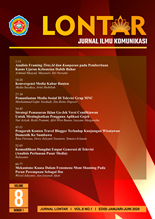Strategi Komunikasi Pemasaran Iklan Go-Jek Versi Cerdikiawan Untuk Meningkatkan Pengguna Aplikasi Go-Jek
DOI:
https://doi.org/10.30656/lontar.v8i1.2028Abstract
Go-jek merupakan aplikasi pelayanan trasnportasi online terbesar di Indonesia. Go-jek diperkenalkan pada tahun 2010 oleh Nadiem Makarim. Semakin hari, kompetitor Go-Jek mulai bermunculan. Maka Go-Jek harus mempersiapkan strategi komunikasi pemasaran yang kreatif agar konsumen setia tetap menggunakan aplikasi tersebut. Tujuan penelitian ini yaitu untuk mengetahui strategi komunikasi pemasaran Iklan Go-Jek versi Cerdikiawan. Penelitian ini menggunakan metode deskriptif kualitatif dengan teknik pengumpulan data melihat iklan Go-Jek di kanal youtube. Teori yang digunakan dalam penelitian ini adalah strategi komunikasi pemasaran khususnya strategi penyusunan pesan melalui media sosial youtube. Hasil penelitian ini menunjukkan bahwa iklan Go-Jek versi Cerdikiawan mampu membuat sugesti kepada khalayak terutama kaum milenial, bahwa siapa saja dapat menjadi cerdikiawan versi masing-masing diri sendiri dengan memanfaatkan segala kreatifitas yang ada. Serta mereka akan selalu menggunakan aplikasi Go-Jek karena merupakan karya anak bangsa dan juga aplikasi ini sangat membantu dalam kehidupan sehari-hari.
Downloads
Published
Issue
Section
License
By submitting an article to the journal, the author(s) agree to transfer the published article's copyright to the journal, which will act as the publisher. This means the journal will have the right to publish the article in various forms, including reprints. The journal will maintain the publishing rights to the published articles.
In line with the license, authors and third parties (readers, researchers, and others) are allowed to share and adapt the material. In addition, the material must be given appropriate credit, provided with a link to the license, and indicated if changes were made. If authors remix, transform, or build upon the material, authors must distribute their contributions under the same license as the original.






